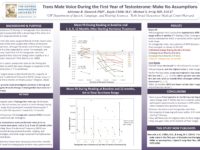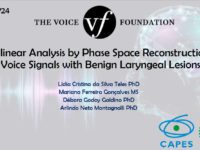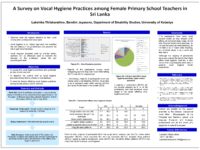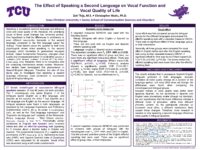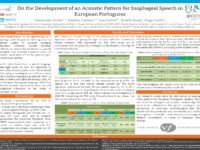Welcome to the 2020 Virtual Poster Session
There are traditional posters and some optional 3-minute poster videos.
Email the First Author with your Questions & Comments
If the bandwidth is exceeded, go directly to our YouTube Playlists
Optional 3-Minute Poster Videos
Effects of corticosteroid inhaler particle size on the voice


Jonelyn Langenstein, MM, MS, CCC-SLP, BCS-S, Clinical Faculty, Northwestern ...University Feinberg School of Medicine: Department of Otolaryngology-Head and Neck Surgery, Chicago, IL
Michiel J Bove, MD, Laryngologist, Northwestern University Feinberg School of Medicine: Department of Otolaryngology-Head and Neck Surgery, Chicago, IL
Caroline P.E. Price, BA, CCRC, Research Coordinator, Northwestern University Feinberg School of Medicine: Department of Otolaryngology-Head and Neck Surgery, Chicago, IL
ABSTRACT:
Importance:
Muscle tension dysphonia (MTD) is defined as excessive tension in the perilaryngeal and laryngeal muscles resulting in discomfort in the affected musculature and complaints of hoarseness. Lower frequency vibration (20−50 Hz) has been used to release muscle tension by inhibiting muscle activity. Localized vibration on the perilaryngeal muscles and whole-body vibration have both shown to be effective methods for relieving vocal fatigue. Due to the convenience of application, direct vibration is used more widely than whole-body vibration. However, there may be additional benefits, to whole-body vibration when postural adjustments are considered. Vocal production is a whole-body activity which can be affected by postural issues and tension outside of the peri laryngeal musculature. Emerging research suggests that whole-body vibration may improve rounded shoulder posture.
Objective:
We aimed to test whether whole-body vibration and resultant whole-body postural adjustments leads to greater relaxation of laryngeal musculature than direct vibration. We predicted that whole-body vibration would have a greater effect on the degree of laryngeal muscle tension due to possible posture-improving effects of the treatment.
Previous studies have established qualitative improvement using self-reported measures of vocal fatigue. We aimed to show improvements in laryngeal relaxation through direct assessment of laryngeal structures using quantitative measurement. The Laryngeal Palpatory Scale (LPS) is a valid and reliable instrument for quantitative measurements of severity of tension and postural issues in the head, neck, and shoulders which impact voice production.
Design/Setting/Participants:
A multiple treatment reversal design was conducted at Northwestern Memorial Hospital, affiliated with Northwestern University on a single subject. The subject was a 23-year-old female with primary MTD. Data collection was performed by an expert clinician, blinded to the experimental condition, who administered the LPS following each session during all phases.
In phase A1, a baseline level on the LPS was established. In phase B, the treatment of whole-body vibration was introduced, in phase C, direct laryngeal vibration (C). The participant will then be returned to a baseline phase before reintroducing each treatment in reverse order to control for carryover effects.
Interventions:
Direct laryngeal vibration: Fovel massager was used to apply vibration to the perilaryngeal muscles at 40 Hz for 10 minutes.
Massage targeted the bilateral sternocleidomastoid muscle, bilateral thyrohyoid space, and submental muscles for 1 minute in each position for two cycles.
Whole-body vibration: Subject stood on a Best Choice Products SKY3197 Full Body Vibration Platform set on a low-frequency setting (40 Hz) for 10 minutes.
Outcome and Measures:
The outcome measure was totaled scores on the LPS compared before and after each treatment.
Data was analyzed and compared between adjacent experimental phases.
Results and conclusions:
The results suggest that both direct laryngeal vibration and whole-body vibration promote relaxation of the perilaryngeal musculature
We did not find that measures on the LPS were lower during full body vibration trials than indirect laryngeal vibration trials.Show More
To Enlarge a Poster, Click on the Picture
Email the First Author with your Questions & Comments
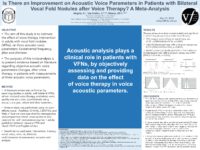
Is There an Improvement on Acoustic Voice Parameters in Patients with Bilateral Vocal Fold Nodules after Voice Therapy? A Meta-Analysis
Rita Alegria, SLP, Susana Vaz-Freitas, PhD, Maria Conceição Manso, PhD
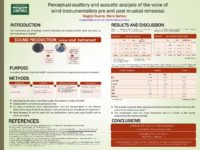 Perceptual-Auditory and Acoustic Analysis of the Voice of Wind Instrumentalists Pre- and Post-Musical Rehearsal
Perceptual-Auditory and Acoustic Analysis of the Voice of Wind Instrumentalists Pre- and Post-Musical Rehearsal
Magda D. Duarte Alves, MS, Mara Behlau, PhD
 Role of Warm-Ups in the Development of Children’s Singing Voice
Role of Warm-Ups in the Development of Children’s Singing Voice
Andrea Asztalos, PhD
Revisiting Nasalance in the Tenor Passaggio: Is it perceptible to Voice Teachers?
Carl Belfatti, MA
Cross-Cultural Adaptation of the Chilean Version of Evaluation of Ability to Sing Easily: EASE
Soledad Correa, SLP, Jean Pierre Contreras, SLP, Daniela Olivares, SLP, Nicolás Cano, SLP
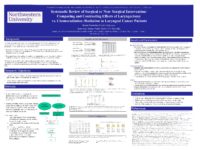 Surgical or Non-Surgical Intervention: Comparing and Contrasting Effects of Laryngectomy vs. Chemoradiation/Radiation in Laryngeal Cancer Patients
Surgical or Non-Surgical Intervention: Comparing and Contrasting Effects of Laryngectomy vs. Chemoradiation/Radiation in Laryngeal Cancer Patients
Natalie Chiappetta, BM
 Characterization of Vocal Pathology in Military Drill Instructors
Characterization of Vocal Pathology in Military Drill Instructors
Amber M. Duvall, MS, Gregory R. Dion, MD
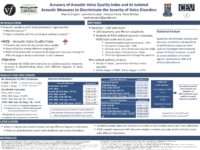 Accuracy of Acoustic Voice Quality Index and its isolated Acoustic Measures to Discriminate the Severity of Voice Disorders
Accuracy of Acoustic Voice Quality Index and its isolated Acoustic Measures to Discriminate the Severity of Voice Disorders
Marina Englert, PhD Candidate, Leonardo Lopes, PhD, Vinicius Vieira, PhD, Mara Behlau, PhD
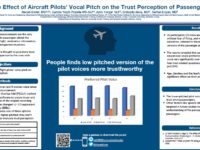 The Effect of Aircraft Pilots’ Vocal Pitch on The Trust Perception of Passengers
The Effect of Aircraft Pilots’ Vocal Pitch on The Trust Perception of Passengers
Necati Enver, MD, Gamze Yeşilli Puzella, MsC, Aylin Torgul, SLP, Erdogdu Akca, MD, Serhat Ergün, MD
Trans Male Voice During the First Year of Testosterone: Make No Assumptions
Adrienne B. Hancock, PhD, Kayla Childs, MA, Michael Irwig, MD, Kristen Schwandes, CCC-SLP
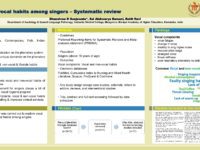 Vocal and Non-Vocal Habits among Singers – Systematic Review
Vocal and Non-Vocal Habits among Singers – Systematic Review
Dhanshree R Gunjawate, PhD, Sai Aishwarya Ramani, MASLP, Rohit Ravi, PhD
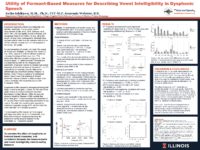 Utility of Formant-Based Measures for Describing Vowel Intelligibility in Dysphonic Speech
Utility of Formant-Based Measures for Describing Vowel Intelligibility in Dysphonic Speech
Keiko Ishikawa, PhD, Jossemia Webster, BS
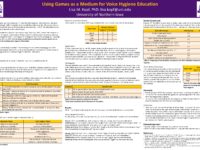 Using Games as a Medium for Voice Hygiene Education
Using Games as a Medium for Voice Hygiene Education
Lisa M. Kopf, PhD
 Perceptions and Time Use of University Voice Students During Self-Guided Practice Sessions
Perceptions and Time Use of University Voice Students During Self-Guided Practice Sessions
Alan J. Martin, PhD
 Adult Normative Data for the OMNI-Vocal Effort Scale
Adult Normative Data for the OMNI-Vocal Effort Scale
Mariah E. Morton, MS, Edie R. Hapner, PhD
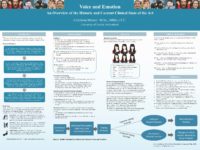 Voice and Emotion: An Overview of the Historic and Current Clinical State of the Art
Voice and Emotion: An Overview of the Historic and Current Clinical State of the Art
Caitriona Munier, MSc
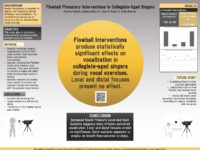 Understanding the Repertoire, Understanding Ourselves: An Analysis of the Musical Canon Used by NATS Teachers
Understanding the Repertoire, Understanding Ourselves: An Analysis of the Musical Canon Used by NATS Teachers
Paul M. Patinka, MM
Narrator Development Program Methodology
Vanessa Pedrosa, PhD, Mariana Jacarandá, SLP, Carolina Newman, SLP, Marcio Moron
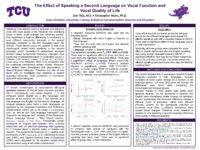 Treatment of Post Intubation Dysphonia and Dysphagia with In-office Medialization Laryngoplasty in a Patient with Diffuse Idiopathic Skeletal Hypertrophy (DISH)
Treatment of Post Intubation Dysphonia and Dysphagia with In-office Medialization Laryngoplasty in a Patient with Diffuse Idiopathic Skeletal Hypertrophy (DISH)
Ruwaa Samarrai, MD, Denis Lafreniere, MD
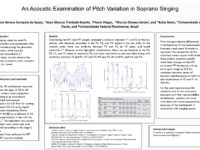 An Acoustic Examination of Pitch Variation in Soprano Singing
An Acoustic Examination of Pitch Variation in Soprano Singing
Glaucia Verena Sampaio de Souza, MD, João Marcos Trindade Duarte, MD, Marcia Simões-Zenari, PhD, Flávia Viegas, PhD, Kátia Nemr, PhD
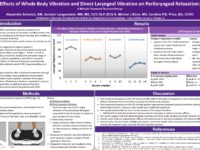 Effects of Total Body Vibration and Direct Laryngeal Vibration on Perilaryngeal Relaxation
Effects of Total Body Vibration and Direct Laryngeal Vibration on Perilaryngeal Relaxation
Alexandra Schenck, BM, Jonelyn Langenstein, MS, Michiel J Bove, MD, Caroline P.E. Price, BA
 Vocal Tract Discomfort in Elementary and High School Teachers
Vocal Tract Discomfort in Elementary and High School Teachers
Mahdi Tahamtan, MSc, Ali Kakavand, MSc, Ronald C. Scherer, PhD
Voice Differences and Quality of Life in Individuals with Marfan Syndrome
Laura Wolford, PhD, CCC-SLP, Ileana Ratiu, PhD, CCC-SLP, Hope Baylow, DA, CCC-SLP, Mitra Esfandiarei, PhD
Relationship between Vocal Fold Collagen Fiber and Young’s Modulus in Beagles
Xinlin Xu, MD, Peiyun Zhuang, MD, Jie Cai, MD, Yu Zhang, PhD, Yue Huang, PhD

